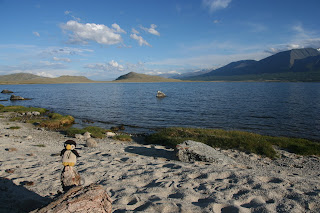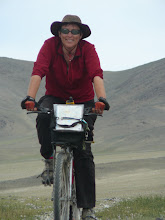Walking home from dinner, I noticed a man riding a bicycle from the vicinity of the ger camp where I was staying.
'That looks like my bike...FUCK, that IS my bike' and I was off.
My companions didn't quite know what to make of it as I started running and yelling after the hapless thief, but they soon came on board.
Luckily he wasn't a very good cyclist and fell off in the loose gravel. He left the bike and took off on foot. A passerby stopped and detained him until we caught up and with my German companions standing guard, I went to retrieve my bike and get the guesthouse owner. Within minutes the police came and he was carted off.
He had forced the lock on my ger, having first looked into them all to find which one had an occupant. Now I lock my bike inside the ger. A useful lesson. I also thank my good fortune for the timing. One more minute and I would have lost it all.

Saturday, August 25, 2007
Thursday, August 23, 2007
The Italians

Met in Ulaangom, and re-met in Olgiy, the Venetian velocipedists peddled into my life like Laurel and Hardy, but with infinitely more style. Only an Italian can still look good while pushing a bike through mud and clouds of mosquitos!
 With time on their side as well, after visiting Khoton Lake together, we filled in the days doing small rides around Olgiy. Inveterate cyclists both of them, they soon had me eating their dust, both uphill and down.
With time on their side as well, after visiting Khoton Lake together, we filled in the days doing small rides around Olgiy. Inveterate cyclists both of them, they soon had me eating their dust, both uphill and down.John (who is actually Scottish) gave me lots of bike tips and Claudio taught me how to swear in the Venetian dialect; both infinitely useful I'm sure.

My thanks to both of you for the great company and next time we meet it will be over a real coffee and tirimisu.
Tuesday, August 21, 2007
Tourist for a time

In an attempt to save my bike (and body) from complete destruction I did the tourist thing and took a 4 day jeep tour out into the border zone. What started out as 3 soon expanded to an international contingent of 7.
The aim was Khoton Lake, but somewhere along the way there was a slight misunderstanding between us and the driver and we headed to a completely different place. After sorting out the mistake and losing a day doubling back, we finally made it to the lake.

Apart from the beauty of the scenery, the lake area is of interest archaeologically. On nearby rocks there are Bronze and Iron age petroglyphs and nearby are Turkic tombs with standing- stones carved in human form.
All very interesting but I am glad I didn't cycle out to see them. It would have been a major undertaking; isolated, unforgiving weather and crap roads, but I would expect no less from this part of the country.
I have also had a glimpse into the tourist industry and it leaves an after-taste not dissimilar to the marmot. With the idea of value for money and 'service' alien to the majority of Mongolians , it would be very easy to develop a jaded, pessimistic view and the opinion that everyone is out to screw you. It makes me glad to be out on my own seeing what the locals really have to offer.
Thursday, August 9, 2007
Downtime

Spent a few days in Bayan-Olgiy, resting my sore body and giving my bike some love and attention.
I am only about 100km south of the border butI have over 2 weeks to kill before I can cross into Russia.
Because of the dry conditions, the road condition has been excellent and has made my progress faster than I originally planned. What I thought would take me 6 weeks, has taken just over 3!
Purgatory is....

.....NW Mongolia.
The roads have deteriorated into a series of corrugations that are impossible to avoid and rocky roads that have my speed down to an average of 7km/h. My body is jarred out of alignment and my hands and shoulders ache. I have to regularly stop to get feeling back into my hands and my palms feel permanently bruised.
All this is joined with afternoon thunderstorms and hail, strong winds and steeper passes.
Yeehah! The things we do for fun.
Salvation

So far, water has been my biggest problem. In some places I have had to carry between 15-20 litres.
An unusually dry winter/summer has left many of the permanent rivers dry.
Crossing up in the north between Barruntarrun and Ulaangom, there was no water for nearly 200km and I ran out.
Gasping from the heat, my tongue swollen, lips cracked and bleeding, I stopped just short of collapsing on the doorstep of this ger, begging for water. In true-to-form Mongolian hospitality, I was ushered inside and plied with liquids and food. After I was re-hydrated, we all sprawled on the floor for a siesta for a few hours before they refilled my water bottles and I continued on my way.
Road through nowhere
Finger-licking good

Open season on marmots has begun, bringing with it once again the annual outbreaks of bubonic plague. What looks like a small beaver is considered a delicacy by the Mongolians and I was fortunate enough to partake in one of these delectable feasts.
The recipe is very easy for those who want to try it at home.
Step 1: Kill the marmot. A clean shot to the head is preferable (it doesn't spoil the meat).
Step 2: Cut off its head and rip out its insides.
Step 3: While heating rocks in a fire, select the cuts of meat and internal organs you want.
Step 4: Re-stuff the body with the herbs/spices, meat and hot rocks, making sure you get them all the way down to the bottom. This step generates a lot of pungent steam, so make sure you do this in a well-ventilated place.
Step 5: Tie up the neck and wait (approximately 30 minutes).
Step 6: Throw the stuffed body on the fire to remove the fur, though a small blowtorch is much more efficient.
Step 7: Open up the neck and pour out the juices that have been generated through the cooking process. Drink this eau-de-marmot.
Step 8: Eat.
I am not quite sure how to describe the taste....somewhere between a decomposing carcass and burnt plastic. It will also repeat on you for hours afterwards so you can re-live the experience for nostalgia's sake. It is also highly recommended you wear gloves during all stages except for the killing. The smell is similar to the taste and is virtually impossible to remove from your fingers, though I didn't try industrial-strength solvent. That could do the trick.
Wednesday, August 8, 2007
Karakorum

"At Sarai in the land of Tartary,
There dwelt a king who warred on Muscovy,
Whereby there died full many a doughty man.
This noble king was known as Cambuskan."
Chaucer
Although originally built by Ghengis Khan as a command post for his invasion into China, it was his son and successor, Ogodei, that rebuilt and re-established Karakorum in emminence on the Silk Road. Under his rule, the city became a major center of trade and politics.
When Kubilai Khan moved the capital to Dadu (China) in 1260, Karakorum fell into decline and was eventually invaded by Chinese and destroyed, though it was never completely abandoned.
What withstood the winds of time and warfare was incorporated into the construction of the Erdene Zuu monastery. The monastery was founded in 1586 following the adoption of Buddhism as the official state religion. Through the ages it has suffered but the majority of the damage, from which it has not recovered, occurred during the state religious purges of the 1930's. It is now a museum and houses religious artifacts that survived or were hidden during the turmoil of the communist era.
All that remains of the monastery are a handful of buildings and the vast stone wall, topped by 108 stupas.
This is what most people come to see when they visit Hahorin, not the inside of a hospital.
Head meets rock.....

.....rock wins.
It's a long story...but basically in the middle of the night a young man thought he would get a bit of something that I didn't want to give him. He got a bit rough,I gave him a bit of a beating, he started throwing stones (and it is very hard to dodge flying rocks when you can't see them!).
Accomodation for my first night in Karakorum (Hahorin) was free. The hospital was basic but clean and the staff was very kind.
Nadaam

While waiting for the visa debacle to finish, I made the most of my time in Ulaan Bator and went to see the Nadaam festival.
Nadaam means game/competition in Mongolian and is the biggest festival of the year. It runs for 3 days, usually in July. It has been held for centuries as a form of religious celebration but now it formally commemorates the 1921 revolution when Mongolia became a free country.
Lots of men wandering around in their underwear....what more could a woman want?!
Ulaan Bator

Like a throwback to a bygone era, Ulaan Bator straddles East and West yet belongs to neither. What would have shone during the communist era has been left to fade into obscurity. The rest of the world has passed by and forgot to take this small, dusty city with it.
Old colonial buildings crumbling with neglect, potholed roads and footpaths a morasse of craters and broken pavers, yet underlying all this is a majesty that hasn't been completely lost.
An interesting place to spend 2 weeks getting visas organised.
Subscribe to:
Comments (Atom)


